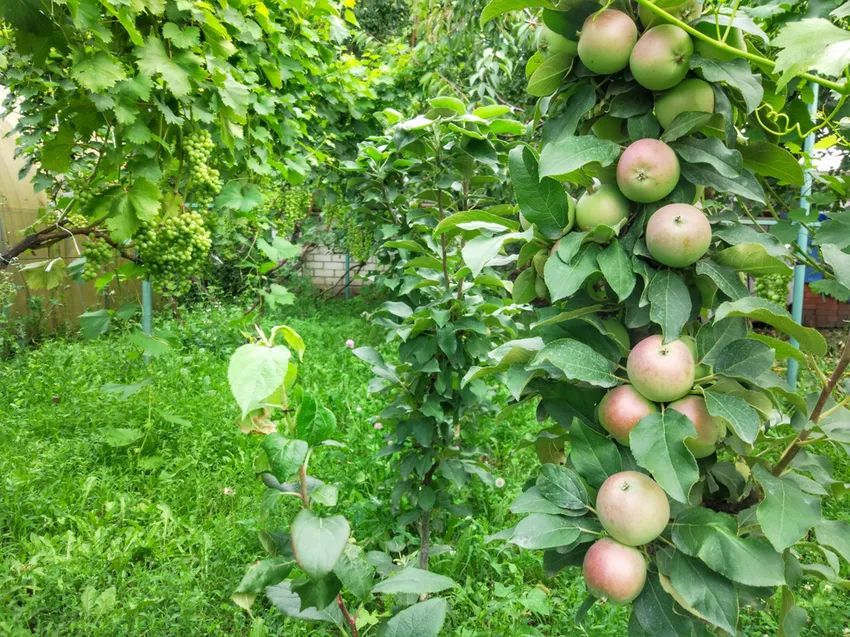- How often should columnar fruit be watered?
- Does columnar fruit often have to be repotted?
- When and how is columnar fruit cut?
- Which pests can become a problem for columnar fruit?
- How to protect columnar fruit from diseases?
- What should be considered when fertilizing columnar fruit?
- How do you get columnar fruit through the winter?
With specially bred columnar fruit varieties, even amateur gardeners can achieve significant yields in a small garden or on a balcony. However, this type of fruit is sometimes a bit delicate and needs regular maintenance, especially when grown in pots.
 Above all, columnar fruit needs regular pruning
Above all, columnar fruit needs regular pruning
How often should columnar fruit be watered?
In a sunny location, you should of course make sure that columnar fruit trees do not dry out in their planters, especially during and after the flowering period. However, it should be sufficient to water vigorously about twice a week. The drainage holes at the base of the pot must not be forgotten, as columnar fruit can die due to waterlogging at the roots. Sometimes it can also make sense not to place the pot on a saucer but on small wooden blocks to ensure some distance to the ground. Like other types of fruit, columnar fruit planted in the garden only requires additional watering directly after planting or during extremely dry periods.
Does columnar fruit often have to be repotted?
Frequent repotting is only necessary for columnar fruit if relatively small planters are used. If you rely on plant pots with a volume of at least 30 or 40 liters from the outset, repotting is only necessary about every 5 years. The substrate should then be renewed and enriched with mature compost for long-term fertilization.
When and how is columnar fruit cut?
In principle, columnar fruit should not only be cut once a desired maximum height has been reached, but should be cut annually from a young age. A distinction is made between the summer cut immediately after the harvest and the winter cut when the juice is dormant. Pruning measures should not only be aimed at maintaining the columnar growth form, but also at increasing the health of the plants by not overly dense foliage.
Which pests can become a problem for columnar fruit?
Aphids are often easier to spot than on large fruit trees due to the compact growth habit of columnar fruit. However, these only have to be actively combated if they multiply rapidly. In this case there are different possibilities:
- use beneficial insects against the aphids in a targeted manner
- Remove aphids with a strong jet of water or a cleaning solution
- If necessary, cut out and dispose of affected shoots
How to protect columnar fruit from diseases?
Columnar apples often have to struggle with scab and mildew, while columnar pears are attacked by pear rust. If no special sprays are to be used against the infestation, the only help is to identify and cut out infested areas at an early stage and to select mildew-resistant apple varieties.
What should be considered when fertilizing columnar fruit?
If columnar fruit is grown in a pot or newly planted in the garden, mature compost and horn shavings (32.93€) can provide a certain long-term fertilization. In addition, the plants should also be supplied with a suitable complete fertilizer to ensure healthy plant growth and a good yield. However, you should no longer fertilize in autumn so that the plants can adjust to the hibernation in good time.
How do you get columnar fruit through the winter?
Unless transplanted too close to the onset of winter, columnar fruit is generally hardy. In very cold locations, columnar peaches and columnar apricots should be wrapped in some garden fleece from time to time, but should then be unpacked again in spring in time for the sprouting. In general, sunny and at the same time draughty locations should be avoided in order to prevent the tree bark from bursting open as a result of large temperature fluctuations.
tips
Even with heavy fertilization, some columnar fruit varieties do not all reach full ripeness and a corresponding fruit sweetness. Even if it hurts every gardener a bit: After flowering, remove some of the too many fruits to get good quality from the rest of the fruits.